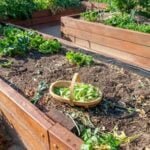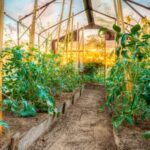Are you looking to start a vegetable garden in an area populated by deer? Vegetable gardening with deer can be a challenge, as these animals are known to devastate crops. In this article, we will explore the various challenges of vegetable gardening in areas with deer populations and provide tips and strategies for successfully protecting your garden from these hungry visitors.
One of the first steps in vegetable gardening with deer is understanding the extent of the deer problem in your area. Deer can pose a significant threat to your crops, especially during certain seasons. Identifying the specific challenges and behaviors of local deer populations will help you develop a targeted approach to protecting your garden.
In this section, we will delve into the various factors that contribute to the deer problem, including their feeding habits and preferences. Understanding these dynamics is essential for implementing effective solutions and safeguarding your vegetable garden from potential damage. We will also discuss the impact of deer browsing on different types of vegetables and offer insights into creating a comprehensive strategy for mitigating these risks.
Choosing Deer-Resistant Vegetables
When it comes to vegetable gardening with deer, one of the key factors to consider is choosing deer-resistant vegetables. These are plant varieties that are less appealing to deer and are therefore less likely to be targeted by these animals.
By selecting the right vegetables for your garden, you can minimize the risk of deer damage and increase the chances of a successful harvest. Here are some vegetable options that are known for their resistance to deer browsing:
- Onions and Garlic: These aromatic plants have strong scents that repel deer, making them an excellent choice for a deer-resistant garden.
- Tomatoes: While not completely immune to deer, tomatoes are less attractive to them compared to other vegetables. Planting them alongside more vulnerable crops can help protect those as well.
- Peppers: Hot peppers, in particular, are known for their resistance to deer due to their spicy nature. Bell peppers also tend to be less appealing to these animals.
In addition to these specific vegetable varieties, there are also certain strategies that can help make your entire garden less inviting to deer.
- Interplanting: Mixing in strongly scented herbs like mint or thyme among your vegetables can help mask the scent of more vulnerable crops.
- Tall Plants as a Barrier: Planting tall, sturdy plants like sunflowers around the perimeter of your garden can create a physical barrier that deters deer from entering.
- Cover Crops: Planting cover crops like clover or rye in between rows of vegetables can provide an extra layer of protection against deer browsing.
By carefully choosing which vegetables to include in your garden and implementing additional deterrents, you can significantly reduce the impact of deer on your vegetable crops. However, it’s important to remember that no method is foolproof, and regular monitoring and adjustment may be necessary when dealing with vegetable gardening in areas with deer populations.
Implementing Physical Barriers
When it comes to protecting your vegetable garden from deer, implementing physical barriers is often one of the most effective strategies. One popular option is to install a tall deer fence around the perimeter of your garden. A fence should be at least 8 feet tall to prevent deer from jumping over it. There are also options for wireless fences that emit a mild electric shock when deer come near, deterring them from entering the garden.
Another physical barrier to consider is a double fence system, which involves two shorter fences placed a few feet apart. This creates a “no man’s land” that makes it more difficult for deer to jump into the garden. Additionally, netting or chicken wire can be used to cover individual plants or rows to provide extra protection from deer browsing.
In addition to fencing, some gardeners use motion-activated sprinklers as a physical deterrent for deer. When the sensors detect movement, they release a sudden burst of water, startling and discouraging deer from entering the garden. A lesser-known method involves using fishing line strung around the garden at various heights, creating an invisible barrier that deters deer without obstructing views or airflow.
Furthermore, incorporating physical deterrents such as noise-making devices or reflective materials can add another layer of defense against deer. Reflective tape or aluminum pie plates hung near the garden can startle and confuse deer with their movement and shine. Noisemakers like wind chimes or bells can also help keep deer away by disrupting their comfort and alerting you to their presence in your vegetable patch.
| Physical Barrier Option | Effectiveness |
|---|---|
| Tall Deer Fence | Highly effective if at least 8 feet tall |
| Motion-Activated Sprinklers | Adequate for deterring deer through surprise and water spray |
| Noise-Making Devices | Helpful in disrupting deer comfort and alerting gardener to their presence |
Natural Repellents and Deterrents
Deer can be a significant challenge for vegetable gardeners, as they are known to feed on a wide variety of plants, including many common vegetables. In areas with deer populations, it is essential to explore natural repellents and deterrents to keep these animals out of the garden. By using scents, plants, and other natural methods, gardeners can effectively discourage deer from entering their growing areas.
One effective natural method for deterring deer from the garden is the use of strong scents. Deer have a keen sense of smell, and certain scents are known to repel them. For example, products containing garlic, pepper, or rotten eggs can be sprayed around the perimeter of the garden to create an unpleasant odor for deer.
Additionally, the scent of human hair or urine can also deter deer from entering the area. These scents can be applied directly onto plants or used in combination with physical barriers for added protection.
In addition to using strong scents, certain plant varieties can help repel deer from the garden. Plants with strong fragrances such as lavender, mint, and marigolds are known to deter deer due to their pungent odors. These plants can be strategically placed throughout the garden to create a natural barrier against deer browsing.
Furthermore, planting thorny or prickly bushes along the perimeter of the garden can also discourage deer from entering. By incorporating these natural deterrents into the garden design, vegetable growers can minimize the likelihood of deer damage to their crops.
| Natural Method | Description |
|---|---|
| Strong Scents | Garlic, pepper, rotten eggs |
| Fragrant Plants | Lavender, mint, marigolds |
| Thorny Bushes | Natural barriers against deer browsing |
Creating a Deer-Proof Garden Design
When designing a vegetable garden in an area with deer populations, it’s crucial to consider layout, plant placement, and other design elements to minimize deer damage. There are several tips and strategies that can help create a deer-proof garden design.
Layout and Structure
One of the first steps in creating a deer-proof garden is to carefully plan the layout and structure. Consider installing fencing around the entire garden area to keep deer out. Additionally, raised beds can be an effective way to deter deer, as they may be less likely to jump into a confined space. Be sure to position the garden in an open, well-lit area where it’s more difficult for deer to hide.
Plant Selection and Placement
When choosing plants for your vegetable garden, opt for varieties that are known to be less appealing to deer. In addition, consider planting these more palatable options closer to your house or in areas where you spend most of your time. This will make it less likely for deer to approach those areas. Surrounding the more attractive plants with those that are unappealing to deer can also help protect them from browsing.
Design Elements
Incorporating certain design elements into your vegetable garden can help minimize its attractiveness to deer. For example, incorporating pathways with rough textures or using materials like gravel or stone can deter deer from walking through the garden. You may also consider adding decorations or structures that create noise or movement, which can help scare off any visiting deer.
By carefully planning the layout, selecting appropriate plants and their placement, and incorporating specific design elements into your vegetable garden, you can greatly reduce the risk of damage caused by deer browsing. These strategies can help create a more resilient and thriving garden despite the presence of deer in the area.
The Role of Companion Planting
Companion planting has been used for centuries as a natural way to protect plants from pests, including deer. By strategically planting certain types of flowers, herbs, and other vegetables alongside your main vegetable crops, you can create an environment that is less attractive to deer. One of the key principles of companion planting is to confuse or repel pests by creating a diverse and complex garden ecosystem.
Some common companion plants that are known to deter deer include strong-smelling herbs like rosemary, thyme, and sage, as well as pungent flowers such as marigolds, daffodils, and lavender. These strong scents can help mask the aroma of more tempting vegetables and discourage deer from browsing in your garden. Additionally, plants with prickly or fuzzy leaves like lamb’s ear or hollyhocks can also act as a deterrent for deer.
In addition to using companion plants for their scent and texture, some gardeners also use certain plants to attract beneficial insects that prey on deer favorites. For example, planting flowers like yarrow or dill can attract ladybugs and lacewings which feed on aphids and other insects that are attractive to deer. By fostering a diverse ecosystem in your garden through companion planting, you can help naturally reduce the risk of deer damage to your vegetable crops.
Protecting Young Plants and Seedlings
Deer can be especially attracted to young plants and seedlings, making them vulnerable to browsing and damage. Fortunately, there are several strategies that gardeners can employ to protect their tender crops from deer interference. Here are some effective methods for safeguarding young plants and seedlings from deer browsing:
1. Physical Barriers: One of the most reliable ways to protect young plants from deer is to use physical barriers such as wire mesh fencing or netting. This creates a barrier that prevents deer from accessing the plants and causing damage. When using fencing, it’s important to ensure that it is tall enough to discourage deer from jumping over it.
2. Repellent Sprays: There are various commercial repellent sprays available that can be applied directly to young plants and seedlings. These sprays emit odors or tastes that deer find unappealing, dissuading them from nibbling on the plants. It’s important to reapply these sprays after rainfall or as directed on the product label for continued protection.
3. Plant-based Deterrents: Some gardeners have found success in planting certain species of flowers and herbs around their young vegetables as a natural deterrent for deer. Plants like marigolds, lavender, and daffodils have scents that repel deer, making them less likely to approach the garden area.
By implementing these strategies, gardeners can effectively protect their delicate young plants and seedlings from deer browsing, allowing them to thrive and produce a bountiful harvest despite the presence of deer in the area.
Managing and Monitoring Deer Activity
Deer are known to be persistent when it comes to finding a meal, and this can pose a challenge for vegetable gardeners. Understanding the behavior of deer and learning how to monitor their activities can help in adjusting gardening practices accordingly.
Tracking Deer Behavior
One of the first steps in managing deer activity in the garden is to understand their behavior patterns. Deer are typically most active during dawn and dusk, so monitoring their movements during these times can provide valuable insight into their feeding habits. Additionally, keeping an eye out for signs of deer presence such as tracks, droppings, and nibbled plants can help in gauging their activity and adjusting gardening strategies accordingly.
Adjusting Gardening Practices
Once the behavior of deer in the area is understood, it’s important to take practical steps to adjust gardening practices accordingly. This may include implementing additional physical barriers such as taller fencing or netting to keep deer out of the garden.
It may also involve being vigilant about protecting vulnerable plants and seedlings by using covers or other protective measures. In some cases, it might be necessary to consider relocating certain vegetables or redesigning the layout of the garden to minimize damage from deer browsing.
Educating Others in the Community
Another important aspect of managing and monitoring deer activity in relation to vegetable gardening is educating others in the community about best practices. Sharing information on effective deterrents, protective measures, and understanding deer behavior can help create a collaborative effort in minimizing damage from deer browsing. It’s also beneficial to stay informed about local regulations and guidelines for managing wildlife interactions while vegetable gardening with deer.
By actively tracking deer behavior and making adjustments to gardening practices accordingly, vegetable gardeners can successfully navigate the challenges of dealing with deer in their gardens while still enjoying bountiful harvests.
Conclusion
In conclusion, vegetable gardening in areas with deer populations can be a challenging but ultimately rewarding endeavor. By understanding the habits and preferences of deer, gardeners can make informed decisions about which vegetable varieties to plant and how to protect them from browsing. Choosing deer-resistant vegetables and implementing physical barriers such as fencing are effective ways to minimize damage to the garden.
In addition to physical deterrents, natural repellents and deterrents can also play a key role in discouraging deer from entering the garden. Using scents, plants, and companion planting can all contribute to creating a less appealing environment for deer. Designing a deer-proof garden layout and protecting young plants and seedlings are important aspects of successfully vegetable gardening with deer as well.
Finally, managing and monitoring deer activity is an ongoing process that requires observation and flexibility. By staying informed about deer behavior and making adjustments accordingly, gardeners can find success in growing vegetables even in areas prone to deer browsing. With careful planning and persistence, it is possible to enjoy the benefits of vegetable gardening while coexisting with deer in the surrounding landscape.
Frequently Asked Questions
How Do You Make a Deer Resistant Vegetable Garden?
Creating a deer-resistant vegetable garden involves choosing plants that are less appealing to deer, such as strong-smelling herbs and plants with fuzzy or prickly textures. Using physical barriers like fences or netting can also help protect the garden from deer browsing.
What Is the Best Deer Deterrent for Vegetable Garden?
The best deer deterrent for a vegetable garden is a combination of strategies. This can include using fencing or netting to physically block deer from accessing the garden, planting deer-resistant crops, using scent-based deterrents like predator urines or soaps, and employing motion-activated sprinklers or noise machines to startle deer away.
Can Deer Out Be Used on Vegetable Plants?
Deer Out can be used on vegetable plants as a repellent to deter deer from feeding on them. It is a natural spray made from food-grade ingredients that gives off an unpleasant odor to deer, but is safe for use on edible plants. Applying and reapplying the spray according to instructions can help protect vegetable plants from deer damage.

If you’re looking to get into vegetable gardening, or are just looking for some tips on how to make your current garden better, then you’ve come to the right place! My name is Ethel and I have been gardening for years. In this blog, I’m going to share with you some of my best tips on how to create a successful vegetable garden.





